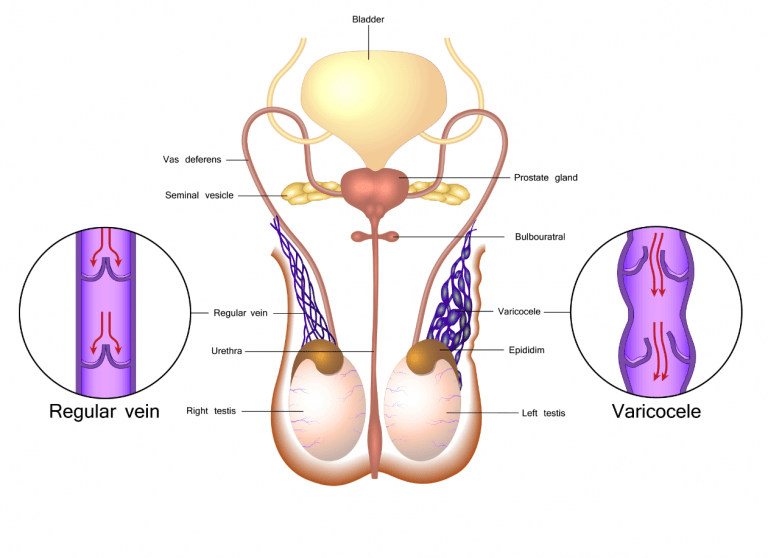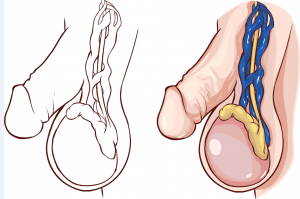Varicocele of Testis (Varicose veins at the testicle)
Learn more about the development, risk factors, and therapy of varicocele (varicose vein on the testicle) on this page.

Varicocele of Testis - What is that?
A varicocele (varicocele of testis) describes a varicose vein in the scrotum. More precisely, it is a varicose vein in the plexus pampiniformis formed by the testicles and epididymis. Most often, the varicose vein in the testicle is located in one of the left testicular veins.
This is another reason why testicular varicose veins are located on the left side in about 80-90% of all cases. The veins that are supposed to carry the blood from the testicles back to the heart are compromised and cannot drain the blood properly. The varicose vein in the testicle causes a venous outflow disorder, which can lead to overheating of the affected testicle.
Men who suffer from a varicose vein in the testicle often know too little about possible treatment and prevention measures from natural medicine. It is important to take the right measures at an early stage to prevent further development of testicular varicose veins. To date, urologists do not agree whether a clinically manifest (subclinical) varicocele alone can be the cause of male infertility.

Untreated testicular varicose veins can become a problem.
In low degrees of severity harmless, an untreated varicose vein in the testicle can, however, progress with age and impair the fertility of the man due to the blood congestion in the scrotum, respectively the resulting overheating of the testicles. This is because the testicles need a temperature about 2-3° Celsius lower than the body temperature for their optimal functioning. That is why the scrotum is located outside the body.
A therapy (surgical procedure) of the varicose vein in the testicle is often carried out only in case of an unfulfilled desire to have children. Urologists still do not agree whether the dilated vein alone is responsible for male infertility.
Therefore, many urologists nowadays recommend a more detailed investigation of the actual causes. Many women can also become pregnant despite a varicocele of testis. The causes of male infertility can be found in many other places in a man’s life and can be eliminated without risk even before a surgical procedure.
For more information on varicocele fertility, see the Natural Treatment Guide.

Varicocele - Why on the left?
This is the reason why 80-90% of varicoceles are on the left side.
The best-known reason why 80-90% of testicular varicoceles are located on the left side is the anatomy of the left testicular vein. This vein opens almost at right angles into the left renal vein, which is why blood drains more poorly on the left side than on the right. In addition, an approximately 10-15 cm higher outflow path of the left testicular vein makes it more difficult for the deoxygenated blood to drain back to the heart. This creates a long hydrostatic column against which the varicose vein in the testicle must fight (especially after prolonged standing / sitting).
Therefore, to help the body heal the varicocele (a varicose vein in the testicle), men with varicose veins in the testicle should take natural countermeasures as early as possible. The sooner you start using the natural measures and methods, the sooner the first tangible and visible results can be achieved.
Natural Treatment After First Symptoms
The natural treatment of varicocele should ideally be done when the dilated vein first becomes noticeable through uncomfortable feelings, such as a twinge or overheating in the scrotum. However, even in more developed cases, the natural treatment methods will greatly help to relieve symptoms such as pain / heaviness / pulling in the testicle, as well as improve fertility and naturally increase testosterone levels in the body. With the difference that the required duration of the natural treatment increases with the severity of the varicose vein in the testicle.
A more or less pronounced varicocele of testis is found in up to 20% of men. Most often, a varicose vein in the testicle develops between the ages of 18 and 25. However, testicular varicose veins can also develop in childhood. However, testicular varicose veins often go unnoticed and are detected as an incidental finding during other urological examinations in adulthood.
Higher grade symptomatic testicular varicose veins can become a real problem for men. The negative influences of the varicose vein in the scrotum on the temperature of the testicles should not be underestimated. A testicular varicose vein can limit a man’s sperm production and also reduce testosterone levels in the blood. Again, the higher the severity, the greater the impairment on fertility and testosterone.
11 Things Men with Varicocele Can Implement Immediately to Stay Safe
Varicocele of Testis - What can I do?
Many men with varicocele make the mistake and ignore the varicose vein in the testicle.
Many men initially ignore the varicose vein in the testicle and only take initial countermeasures relatively late to prevent further development of the varicocele (varicose vein testicle). These include, for example, wearing suitable varicocele clothing. Especially with regard to fertility, “man” should make sure when choosing underwear that it is made of thin material, if possible, to achieve good ventilation. At the same time, underwear suitable for varicocele should support and slightly compress the scrotum to:
- Prevent severe sagging of the scrotum (is a risk factor for further development of varicocele, especially with higher grade testicular varicose veins),
- Improve blood flow to the varicose vein through compression, thereby preventing further development (similar to a compression stocking on the legs).
This natural method of treatment of varicose veins in the testicle is often one of the first measures that men with testicular varicose veins take themselves, either on the basis of their own understanding or as a result of advice from a urologist.
Also, useful is the intake of varicocele suitable natural supplements. For example, the daily intake of grape seed extract (OPC) can naturally treat daily form-dependent complaints such as varicocele pain / pulling / pinching in the testicles.
Varicocele Causes: Primary and Secondary Varicocele
Primary varicocele
A distinction is made between primary and secondary varicocele. The primary testicular varicocele has its cause in the almost right-angled confluence of the testicular vein with the left renal vein. In combination with venous valve insufficiency, a long hydrostatic pressure column develops, against which the testicular vein has to fight against the spermatic cord (Plexus Pampiniformis).
Venous valve insufficiency most often occurs due to age, but it may also have been caused by certain behaviors of the affected individual himself. For example, venous outflow obstruction as a result of increased vascular pressure may have caused a primary varicose vein in the testis. Due to anatomical conditions, primary testicular varicose veins occur on the left side in about 90% of cases.
Secondary varicocele (often also: varicose vein testis bilateral)
Varicocele bilateral: secondary testicular varicose veins can occur on both sides. The cause of a secondary testicular varicocele can be, for example, a tumor-related outflow congestion. The tumor is usually located on the kidney, in the renal pelvis or on the ureter. However, a narrowing of the renal vein between the aorta and the abdominal artery (nutcracker syndrome) and the associated venous outflow obstruction of the left testicular vein can also lead to a secondary testicular varicose vein.

Varicocele: Examination and Diagnosis
Low-grade testicular varicose veins can often be palpated with the fingers and can be visualized by the urologist using Doppler sonography (ultrasound) on the screen. An examination of the testicular varicose vein should be performed both with the patient standing and lying down. If the suspicion is confirmed by the “palpation test”, a more detailed examination of the veins on the screen is usually performed.
In order to visualize the exact course of the damaged vein, care should be taken to ensure that not only the varicocele itself is x-rayed, but also the surrounding abdominal and renal areas. In the further course of the examination, semen analysis of the affected person is made to determine the current state of his fertility. Control visits to the urologist and annual evaluations of the semen analysis are generally recommended for all varicocele patients. Especially if the affected person has a desire to have children.
Whether varicocele surgery or sclerotherapy can actually improve fertility after varicocele is still a matter of controversial debate among medical specialists. Many women today can become pregnant despite male varicocele. Different studies and opinions cannot make a clear statement about varicocele surgery until today.
Therefore, it is important that those affected inform themselves as early as possible about the testicular varicocele and the various conventional medical and natural therapy options. In this way, the chances and risks can be properly assessed, and the right decision can be made in the individual case.
Are men helpless against testicular varicose veins?
Contrary to popular belief, sufferers can do a great deal about the various causes of a varicose vein in the testicle. Click here for a free initial consultation. Read the guide “Successful treatment of varicocele” at least once from cover to cover and then start the natural treatment risk-free. Only in this way will you be on the safe side and be able to make the right decisions for you.
Varicocele: Treatment and Chances of Success
Varicocele in children: Prompt treatment is not always necessary for a varicose vein on the testicle. Especially in childhood, spontaneous regression of testicular varicose veins is very common. Varicocele regression: However, regression of the varicose vein on the testicle can also be achieved in young adults if appropriate natural countermeasures are taken.
Varicocele alternative treatment: To treat varicose veins on the testicle itself, men should, for example, start wearing appropriate varicocele underwear as soon as possible. This will prevent sagging of the scrotum in everyday life, and at the same time significantly reduce swelling by cooling and compression.
Varicocele surgery: a testicular varicocele of testis should only be treated surgically if:
- The man suffers from persistent severe varicocele pain or natural methods fail to restore healthy blood circulation so that the pain subsides.
- There is a desire to have children, and all other gentle methods and means of improving fertility have not brought any improvement.
- The man is significantly restricted in his lifestyle and despite using natural varicocele treatment over a longer period of 3-6 months there is no improvement.
Read on now to learn more about varicocele and the different treatment methods.
